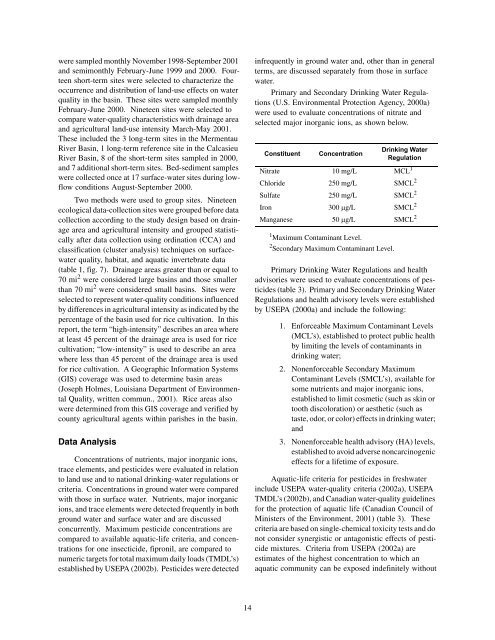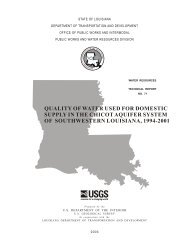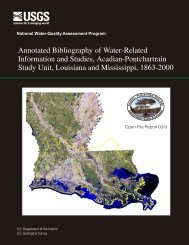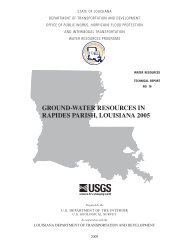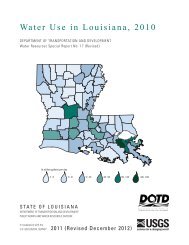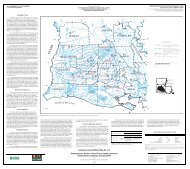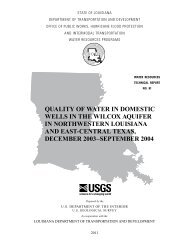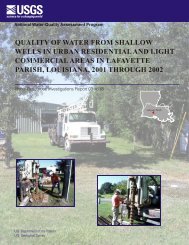environmental setting, water quality, and ecological indicators of
environmental setting, water quality, and ecological indicators of
environmental setting, water quality, and ecological indicators of
You also want an ePaper? Increase the reach of your titles
YUMPU automatically turns print PDFs into web optimized ePapers that Google loves.
were sampled monthly November 1998-September 2001<br />
<strong>and</strong> semimonthly February-June 1999 <strong>and</strong> 2000. Fourteen<br />
short-term sites were selected to characterize the<br />
occurrence <strong>and</strong> distribution <strong>of</strong> l<strong>and</strong>-use effects on <strong>water</strong><br />
<strong>quality</strong> in the basin. These sites were sampled monthly<br />
February-June 2000. Nineteen sites were selected to<br />
compare <strong>water</strong>-<strong>quality</strong> characteristics with drainage area<br />
<strong>and</strong> agricultural l<strong>and</strong>-use intensity March-May 2001.<br />
These included the 3 long-term sites in the Mermentau<br />
River Basin, 1 long-term reference site in the Calcasieu<br />
River Basin, 8 <strong>of</strong> the short-term sites sampled in 2000,<br />
<strong>and</strong> 7 additional short-term sites. Bed-sediment samples<br />
were collected once at 17 surface-<strong>water</strong> sites during lowflow<br />
conditions August-September 2000.<br />
Two methods were used to group sites. Nineteen<br />
<strong>ecological</strong> data-collection sites were grouped before data<br />
collection according to the study design based on drainage<br />
area <strong>and</strong> agricultural intensity <strong>and</strong> grouped statistically<br />
after data collection using ordination (CCA) <strong>and</strong><br />
classification (cluster analysis) techniques on surface<strong>water</strong><br />
<strong>quality</strong>, habitat, <strong>and</strong> aquatic invertebrate data<br />
(table 1, fig. 7). Drainage areas greater than or equal to<br />
70 mi 2 were considered large basins <strong>and</strong> those smaller<br />
than 70 mi 2 were considered small basins. Sites were<br />
selected to represent <strong>water</strong>-<strong>quality</strong> conditions influenced<br />
by differences in agricultural intensity as indicated by the<br />
percentage <strong>of</strong> the basin used for rice cultivation. In this<br />
report, the term “high-intensity” describes an area where<br />
at least 45 percent <strong>of</strong> the drainage area is used for rice<br />
cultivation; “low-intensity” is used to describe an area<br />
where less than 45 percent <strong>of</strong> the drainage area is used<br />
for rice cultivation. A Geographic Information Systems<br />
(GIS) coverage was used to determine basin areas<br />
(Joseph Holmes, Louisiana Department <strong>of</strong> Environmental<br />
Quality, written commun., 2001). Rice areas also<br />
were determined from this GIS coverage <strong>and</strong> verified by<br />
county agricultural agents within parishes in the basin.<br />
Data Analysis<br />
Concentrations <strong>of</strong> nutrients, major inorganic ions,<br />
trace elements, <strong>and</strong> pesticides were evaluated in relation<br />
to l<strong>and</strong> use <strong>and</strong> to national drinking-<strong>water</strong> regulations or<br />
criteria. Concentrations in ground <strong>water</strong> were compared<br />
with those in surface <strong>water</strong>. Nutrients, major inorganic<br />
ions, <strong>and</strong> trace elements were detected frequently in both<br />
ground <strong>water</strong> <strong>and</strong> surface <strong>water</strong> <strong>and</strong> are discussed<br />
concurrently. Maximum pesticide concentrations are<br />
compared to available aquatic-life criteria, <strong>and</strong> concentrations<br />
for one insecticide, fipronil, are compared to<br />
numeric targets for total maximum daily loads (TMDL’s)<br />
established by USEPA (2002b). Pesticides were detected<br />
14<br />
infrequently in ground <strong>water</strong> <strong>and</strong>, other than in general<br />
terms, are discussed separately from those in surface<br />
<strong>water</strong>.<br />
Primary <strong>and</strong> Secondary Drinking Water Regulations<br />
(U.S. Environmental Protection Agency, 2000a)<br />
were used to evaluate concentrations <strong>of</strong> nitrate <strong>and</strong><br />
selected major inorganic ions, as shown below.<br />
Constituent Concentration<br />
Drinking Water<br />
Regulation<br />
Nitrate 10 mg/L MCL 1<br />
Chloride 250 mg/L SMCL 2<br />
Sulfate 250 mg/L SMCL 2<br />
Iron 300 µg/L SMCL 2<br />
Manganese 50 µg/L SMCL 2<br />
1 Maximum Contaminant Level.<br />
2 Secondary Maximum Contaminant Level.<br />
Primary Drinking Water Regulations <strong>and</strong> health<br />
advisories were used to evaluate concentrations <strong>of</strong> pesticides<br />
(table 3). Primary <strong>and</strong> Secondary Drinking Water<br />
Regulations <strong>and</strong> health advisory levels were established<br />
by USEPA (2000a) <strong>and</strong> include the following:<br />
1. Enforceable Maximum Contaminant Levels<br />
(MCL’s), established to protect public health<br />
by limiting the levels <strong>of</strong> contaminants in<br />
drinking <strong>water</strong>;<br />
2. Nonenforceable Secondary Maximum<br />
Contaminant Levels (SMCL’s), available for<br />
some nutrients <strong>and</strong> major inorganic ions,<br />
established to limit cosmetic (such as skin or<br />
tooth discoloration) or aesthetic (such as<br />
taste, odor, or color) effects in drinking <strong>water</strong>;<br />
<strong>and</strong><br />
3. Nonenforceable health advisory (HA) levels,<br />
established to avoid adverse noncarcinogenic<br />
effects for a lifetime <strong>of</strong> exposure.<br />
Aquatic-life criteria for pesticides in fresh<strong>water</strong><br />
include USEPA <strong>water</strong>-<strong>quality</strong> criteria (2002a), USEPA<br />
TMDL’s (2002b), <strong>and</strong> Canadian <strong>water</strong>-<strong>quality</strong> guidelines<br />
for the protection <strong>of</strong> aquatic life (Canadian Council <strong>of</strong><br />
Ministers <strong>of</strong> the Environment, 2001) (table 3). These<br />
criteria are based on single-chemical toxicity tests <strong>and</strong> do<br />
not consider synergistic or antagonistic effects <strong>of</strong> pesticide<br />
mixtures. Criteria from USEPA (2002a) are<br />
estimates <strong>of</strong> the highest concentration to which an<br />
aquatic community can be exposed indefinitely without


